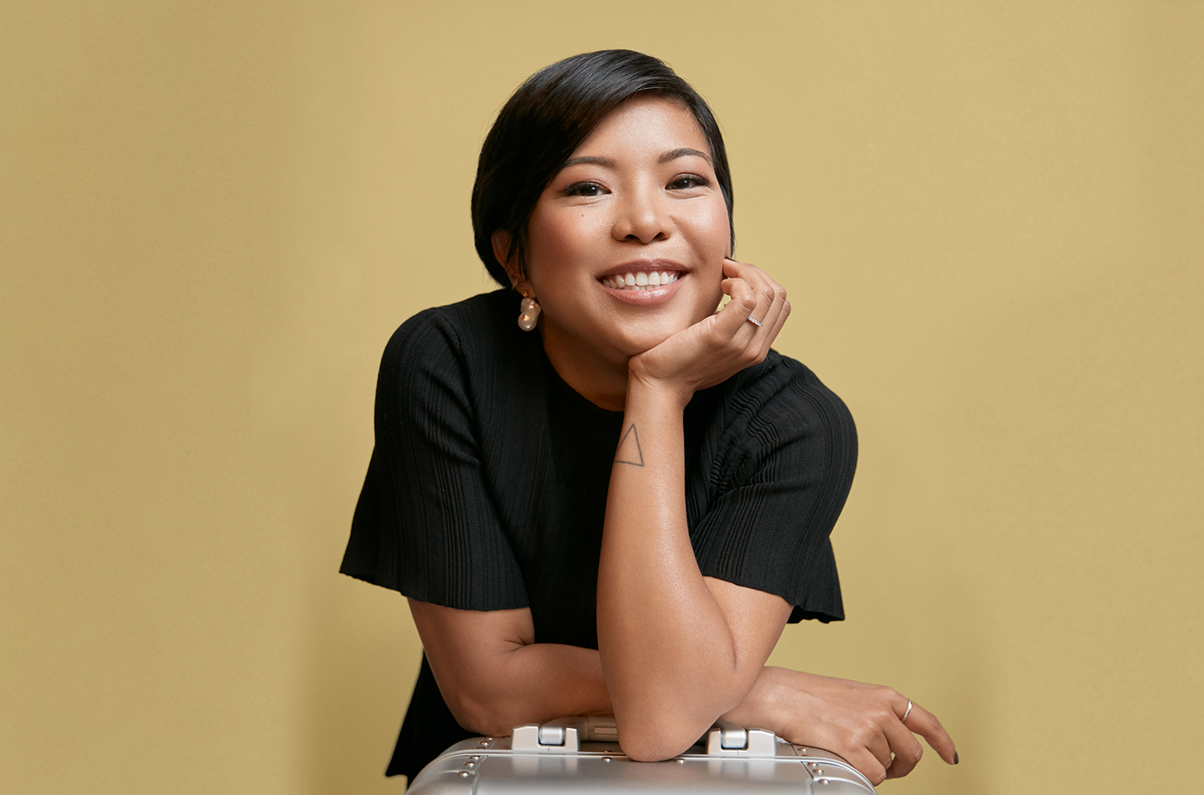[vc_row full_width=”stretch_row_content” full_height=”yes” parallax=”content-moving” parallax_image=”14355″ parallax_speed_bg=”1″][vc_column][vc_empty_space height=”550px”][/vc_column][/vc_row][vc_row full_width=”stretch_row” parallax=”content-moving-fade” parallax_image=”14394″ parallax_speed_bg=”1.2″][vc_column][vc_custom_heading text=”Interview by Lance Chung | Photography by Chris Loupos
” font_container=”tag:h6|font_size:16|text_align:center|color:%23ffffff” google_fonts=”font_family:Dosis%3A200%2C300%2Cregular%2C500%2C600%2C700%2C800|font_style:400%20regular%3A400%3Anormal”][vc_separator color=”black” el_width=”70″ css_animation=”fadeIn” css=”.vc_custom_1571947614016{padding-top: 4px !important;}”][vc_column_text]The genesis of Away all started with Jen Rubio and her frustration with the travel experience. After realizing a gap in the market for thoughtfully-designed luggage, Rubio embarked on a journey to create a company that would alleviate the stresses and highlight the joys of travelling. Four-and-a-half years later, with her co-founder Steph Korey, Away has raised $100 million in their latest round of fundraising, bringing the valuation of the company to $1.4 billion and securing the holy grail title of the entrepreneurial community — unicorn status. With over a million suitcases sold, $300 million in revenue projected for 2019, and an ambitious retail expansion to open 50 stores over the next three years (Toronto, included), Away is revolutionizing the travel industry.
Today, it’s clear that Away has resonated with the marketplace, proving Rubio’s hypothesis for an industry in need of a rebrand. Here’s how she did it.[/vc_column_text][/vc_column][/vc_row][vc_row full_width=”stretch_row” parallax=”content-moving” parallax_image=”14411″ parallax_speed_bg=”1.2″][vc_column width=”1/2″][vc_empty_space height=”10px”][vc_single_image image=”14373″ img_size=”full” onclick=”link_image” css_animation=”none”][/vc_column][vc_column width=”1/2″][vc_custom_heading text=”You both come from Warby Parker. What did you take away from your experience working there?
” font_container=”tag:h2|font_size:22|text_align:left|color:%23ffffff” google_fonts=”font_family:Oswald%3A300%2Cregular%2C700|font_style:400%20regular%3A400%3Anormal” css_animation=”fadeInRight”][vc_column_text]What we learned at Warby was that the true benefit of a direct-to-consumer company is the relationship that you have with your customers. They will tell you everything you need to know: what your product should be, where your store should open, what you should be doing online. I think the number one thing we really learned was to listen, take everything that we heard, and feed it back into the customer’s experience at every single touchpoint of the brand. Even now, we’ve grown to almost 300 people in three years and have to constantly remind all of the new members that what we’re creating isn’t about previous experience. It’s not about what you think should happen. We have all of the data and insights that tell us what to do and that’s really how we’re shaping the company. [/vc_column_text][/vc_column][/vc_row][vc_row full_width=”stretch_row” parallax=”content-moving” parallax_image=”14405″ parallax_speed_bg=”1.2″][vc_column][vc_custom_heading text=”How important was it to find the right co-founder when you were first building Away?” font_container=”tag:h2|font_size:22|text_align:left|color:%23ffffff” google_fonts=”font_family:Oswald%3A300%2Cregular%2C700|font_style:400%20regular%3A400%3Anormal” css_animation=”fadeInLeft”][vc_column_text]I would not trade having a co-founder for the world, but I do think that if you don’t have the right one, it’s better to do it alone. You shouldn’t look for a co-founder for the sake of having one because it is like a marriage. When we were raising our seed round, we got a lot of questions about our dynamic and how we would split the work. You realize investors are just looking to see if the two people who are starting a company are going to survive.
I think the reason Steph [Korey] and I are so great together is because we have totally complementary skill sets. She’s left brain, and I’m right. It means that I have the freedom to be my best self because I’m not worrying about the things that I’m not good at. [/vc_column_text][vc_custom_heading text=”As you were laying down the bricks of your foundation as a company, how long did it take for you both to find confidence as business owners?” font_container=”tag:h2|font_size:22|text_align:left|color:%23ffffff” google_fonts=”font_family:Oswald%3A300%2Cregular%2C700|font_style:400%20regular%3A400%3Anormal” css_animation=”fadeInLeft”][vc_column_text]It’s definitely a muscle that you build over time. I think that where the confidence comes from is directly correlated to your excitement about what you’re doing. Any time we had a conversation, whether it was to an investor, or to a factory that we were trying to work with, or to a potential customer, that excitement came off as confidence.
I always tell other founders, both new ones and up-and-coming entrepreneurs, that they really have to be excited about what they’re working on, which seems really obvious. But for some people, they’re just trying to work on anything; they just want to be a founder of something. But when you’re a founder, you’re basically a salesperson all the time. You’re constantly selling the company to press, to your customers, to each other, and to employees if you’re trying to get people to come work for you. And if you’re spending every waking hour trying to sell something you’re not excited about, then that will drain you very, very quickly. [/vc_column_text][/vc_column][/vc_row][vc_row full_width=”stretch_row” parallax=”content-moving” parallax_image=”14391″ parallax_speed_bg=”1.2″][vc_column][vc_empty_space height=”550px”][/vc_column][/vc_row][vc_row full_width=”stretch_row” parallax=”content-moving” parallax_image=”14393″ parallax_speed_bg=”1″][vc_column][vc_custom_heading text=”You’ve gone through multiple rounds of funding. How did you determine how much money you initially needed to raise?” font_container=”tag:h2|font_size:22|text_align:left|color:%23ffffff” google_fonts=”font_family:Oswald%3A300%2Cregular%2C700|font_style:400%20regular%3A400%3Anormal” css_animation=”fadeInLeft”][vc_column_text]Our very first round was a $150,000 friends and family round, which we knew was enough to help us bring the product to life. We used that money to hire an industrial designer to turn our back-of-napkin sketches into real designs and to travel to China where our first bags were made. Once we nailed down the process, we realized how much it costs to make a suitcase and the scale of our plans.
We went into our seed round thinking we’d raise about a million dollars to help us place our first big order in the factory, hire our first employees, and launch the company. There was a lot of excitement around what we were doing and we ended up raising two-and-a-half million.[/vc_column_text][vc_row_inner][vc_column_inner width=”1/3″][vc_empty_space height=”60px”][vc_custom_heading text=”“It was easier to get $100 million of investment than it was to get that first $25,000 cheque.“” font_container=”tag:h2|font_size:42|text_align:left|color:%23ffffff” google_fonts=”font_family:Italiana%3Aregular|font_style:400%20regular%3A400%3Anormal”][/vc_column_inner][vc_column_inner width=”2/3″][vc_custom_heading text=”How was your experience different between each round of fundraising?” font_container=”tag:h2|font_size:22|text_align:left|color:%23ffffff” google_fonts=”font_family:Oswald%3A300%2Cregular%2C700|font_style:400%20regular%3A400%3Anormal” css_animation=”fadeInLeft”][vc_column_text]It was night and day. Seed fundraising is always completely different than any other one. When you’re first raising money for your company and trying to get seed capital, you’re pitching yourself, your ideas, and your ability to execute that. You have literally no proof points. You’re selling the dream, and you have to do it in a way where that makes sense to an investor.
Once you get into the later rounds, it’s all about the traction that you have. We are pretty rigorous in timing our raises. If we want to raise eight to $10 million and don’t want to give up too much of the company, we’ll figure out how much we need to be doing in sales. By that point, you have things to show your investors. You can show them your traction, growth, and production over the last six months. You’re still selling the dream, but in a lot of ways they’re looking at what you’ve been able to do with that first batch of capital. Then, as you progress, it actually gets easier. We just raised $100 million and those have probably been our easiest fundraising conversations over the years. It was easier to get $100 million of investment than it was to get that first $25,000 cheque because we had so much data from our customers and a very strong sense of what we wanted to do with the capital. [/vc_column_text][/vc_column_inner][/vc_row_inner][vc_custom_heading text=”So, ultimately the financials are emphasized more the further you progress through each round?” font_container=”tag:h2|font_size:22|text_align:left|color:%23ffffff” google_fonts=”font_family:Oswald%3A300%2Cregular%2C700|font_style:400%20regular%3A400%3Anormal” css_animation=”fadeInLeft”][vc_column_text]Yeah. I think the further you get along with the business, it becomes less about you and more about what you’ve been able to do with the numbers. It’s not totally true with our latest investors because they’re also public market investors and they try to determine if you can run the company for a long time and take it to the next level. But you also get better at it over time. You learn how to frame your pitch and the kinds of questions that investors are going to ask you. [/vc_column_text][/vc_column][/vc_row][vc_row full_width=”stretch_row” parallax=”content-moving” parallax_image=”14417″ parallax_speed_bg=”1.2″][vc_column][vc_empty_space height=”550px”][/vc_column][/vc_row][vc_row full_width=”stretch_row” parallax=”content-moving” parallax_image=”14422″ parallax_speed_bg=”1.2″][vc_column][vc_custom_heading text=”With that experience behind you, how do you prepare before going into an investor meeting?” font_container=”tag:h2|font_size:22|text_align:left|color:%23ffffff” google_fonts=”font_family:Oswald%3A300%2Cregular%2C700|font_style:400%20regular%3A400%3Anormal” css_animation=”fadeInLeft”][vc_column_text]I think both sides should be thinking about the same thing. If you’re looking for seed investment, what’s the problem that you’re trying to solve? How are you solving it? Why are you the one who is uniquely positioned to solve this in the market, and how big is the market? We knew the problem we were trying to solve was that the luggage industry was broken. We were going to create a beloved direct-to-consumer brand that cuts out the middleman and is built on consumer insights. Why were we uniquely positioned to solve it? Because we had experience with the direct-to-consumer [model], a vision for a travel brand, and the size of the market. We looked at the data and the luggage industry was $32 billion globally. I think that paints a really compelling picture. [/vc_column_text][/vc_column][/vc_row][vc_row full_width=”stretch_row” parallax=”content-moving” parallax_image=”14421″ parallax_speed_bg=”1.2″][vc_column][vc_custom_heading text=”In November of 2018, Away received a $100 million investment led by Wellington Management Company that took your valuation to $1.4 billion. What does it mean to be a unicorn company of female founders?” font_container=”tag:h2|font_size:22|text_align:left|color:%23ffffff” google_fonts=”font_family:Oswald%3A300%2Cregular%2C700|font_style:400%20regular%3A400%3Anormal” css_animation=”fadeInLeft”][vc_column_text]It’s a responsibility that we take on because in the public or private market, once you cross this valuation threshold, there is a shift in perception. [/vc_column_text][vc_column_text]We’re the same people that we were when the company was worth $700 million, and now it’s worth $1.4 billion. But there is a shift in perception, and people are more curious about the company and paying more attention. There’s more on the line. I think any founder of any gender is watched more closely once you reach this kind of scale.
As a female founder, there’s always a feeling that you should be setting an example for others. I think it’s a really great opportunity for us to show everyone how companies run by anyone should operate. It’s a great platform to help the next generation of female entrepreneurs. [/vc_column_text][/vc_column][/vc_row][vc_row full_width=”stretch_row” parallax=”content-moving” parallax_image=”14423″ parallax_speed_bg=”1.1″][vc_column width=”2/3″][vc_custom_heading text=”Is the “female entrepreneur” designation a title that you embrace?” font_container=”tag:h2|font_size:22|text_align:left|color:%23ffffff” google_fonts=”font_family:Oswald%3A300%2Cregular%2C700|font_style:400%20regular%3A400%3Anormal” css_animation=”fadeInLeft”][vc_column_text]I laugh because when we were raising our series A and early rounds, we would get a bunch of press that focused on that. And we were like, “No, don’t call us female founders! We’re just founders.” We were so resistant to it because we still had a lot to prove and didn’t want to feel like we were getting attention just because we were female entrepreneurs. Now, we’re of a certain size where we’re past that and are actually embracing the fact that there aren’t a lot of women in this position. We want to set a good example for what that should look like. [/vc_column_text][/vc_column][vc_column width=”1/3″][vc_single_image image=”14420″ img_size=”full” onclick=”link_image”][/vc_column][/vc_row][vc_row full_width=”stretch_row” parallax=”content-moving” parallax_image=”14424″ parallax_speed_bg=”1.1″][vc_column][vc_custom_heading text=”Have you come across any challenges that you think are unique to women, or perhaps more frequent, when it comes to raising investment capital?” font_container=”tag:h2|font_size:22|text_align:left|color:%23ffffff” google_fonts=”font_family:Oswald%3A300%2Cregular%2C700|font_style:400%20regular%3A400%3Anormal” css_animation=”fadeInLeft”][vc_column_text]We’re in a time where there have been a lot of stories around discrimination and inappropriate behaviour. Truthfully, Steph and I have never experienced blatant shows of that. But I think where women really struggle is around the microaggressions and unconscious bias that people have. During a conversation, if someone’s not listening or being dismissive, you don’t know if that’s their personality or if it’s because you’re being discounted as a woman. Those are things that I think are harder to prepare for. What it comes down to is really just having the confidence in your pitch and who you’re talking to, and also doing a lot of reference checking.
New entrepreneurs don’t realize that there are two sides to the table. Obviously when you have an exciting idea, you want to get a lot of yeses and feel like you’re asking for a lot. But investors are also just looking for great opportunities to invest. It is just as important that you are asking their portfolio of founders and the people they work for how they’ve been like to work with because that’s not something you’re going to learn in an hour-long meeting. [/vc_column_text][/vc_column][/vc_row][vc_row full_width=”stretch_row” parallax=”content-moving” parallax_image=”14422″ parallax_speed_bg=”1.1″][vc_column width=”1/3″][vc_single_image image=”14425″ img_size=”full” onclick=”link_image”][vc_custom_heading text=”“You don’t want someone second guessing your tactics. Alignment on the vision is really important.“” font_container=”tag:h2|font_size:38|text_align:left|color:%23ffffff” google_fonts=”font_family:Italiana%3Aregular|font_style:400%20regular%3A400%3Anormal”][/vc_column][vc_column width=”2/3″][vc_custom_heading text=”What traits and values do you look for in an investor that wants to work with you?” font_container=”tag:h2|font_size:22|text_align:left|color:%23ffffff” google_fonts=”font_family:Oswald%3A300%2Cregular%2C700|font_style:400%20regular%3A400%3Anormal” css_animation=”fadeInLeft”][vc_column_text]It’s exactly that — an alignment of values. You have to be really clear on what your vision is for the company and make sure that the investors you’re bringing on get that. If they’re aligned with the company vision, then you’re not going to have to explain every decision that you make. It’s like a long-term relationship.
For example, when we were raising our seed round, we were very excited about the potential to build a travel brand that didn’t exist yet. That’s not a pitch that really resonated with some of the investors that we worked with. They were like, “This is a luggage company. These are the margins, this is the business.” And there were investors who were sold the direct-to-consumer aspect of it, but didn’t really care that we wanted to do it a certain way by building a brand and community, and by doing all these things that fuel what Away is now.
We chose not to work with those investors because if they wanted to invest in a direct-to-consumer luggage company, we would have had to explain every long-term brand decision, everything we couldn’t measure. You don’t want someone second guessing your tactics. Alignment on the vision is really important. [/vc_column_text][/vc_column][/vc_row][vc_row full_width=”stretch_row” parallax=”content-moving” parallax_image=”14427″ parallax_speed_bg=”1.2″][vc_column][vc_empty_space height=”500px”][/vc_column][/vc_row][vc_row full_width=”stretch_row” parallax=”content-moving” parallax_image=”14393″ parallax_speed_bg=”1″][vc_column][vc_custom_heading text=”Was it difficult to find investors that would give you that freedom?” font_container=”tag:h2|font_size:22|text_align:left|color:%23ffffff” google_fonts=”font_family:Oswald%3A300%2Cregular%2C700|font_style:400%20regular%3A400%3Anormal” css_animation=”fadeInLeft”][vc_column_text]No. I’m biased, but I think the great ones just let you do your thing and when you need help, they’re there. One thing that I always do when I’m reference checking investors is talk to a founder that they’ve worked with for awhile and ask them how the investor treated them when the company wasn’t doing well. When you have a ton of momentum and the investor wants to work with you, they’ll treat you one way. But it’s more about what happened when you missed your numbers for a few months. Did they step in to help or were they aggressive? Asking those questions is very important. [/vc_column_text][vc_custom_heading text=”What advice do you have for other women when it comes to navigating difficult business conversations?” font_container=”tag:h2|font_size:22|text_align:left|color:%23ffffff” google_fonts=”font_family:Oswald%3A300%2Cregular%2C700|font_style:400%20regular%3A400%3Anormal” css_animation=”fadeInLeft”][vc_column_text]I don’t think you should even be having an investor conversation if you don’t know what you want. What I see too much of — and this does apply more to women in my experience — is someone going into a conversation not knowing where it could go. This isn’t like going on a Tinder date. It’s a business conversation and you should go into it knowing if you’re there to fundraise. And if so, how much?[/vc_column_text][vc_custom_heading text=”How important is that first impression?” font_container=”tag:h2|font_size:22|text_align:left|color:%23ffffff” google_fonts=”font_family:Oswald%3A300%2Cregular%2C700|font_style:400%20regular%3A400%3Anormal” css_animation=”fadeInLeft”][vc_column_text]You have to have a really strong sense of what your goal is. Not every conversation has to be a business transaction, but at least know what you want to get out of it. I’ll go into them and say, “What I want out of this is to build a relationship with this person so that this can happen in the future.” I’ve had so many people tell me that they’ve gone and spent time with an investor only to have the conversation fizzle and nothing happen because there was no real follow up.
People think they’re just talking to someone and, as a result, don’t put their best foot forward or come prepared. You should treat every investor interaction as if you are fundraising or as if they’re evaluating you because when the time comes for them to finally make that decision, they’re going to take all those things into account. [/vc_column_text][vc_row_inner][vc_column_inner width=”2/3″][vc_column_text]Here at Away, I’ve seen people come in for an interview. They’ll be great in the interview but be rude to the receptionist or other people waiting. I think to myself, “Wow, I just interviewed this person and saw them be rude to someone else just because they weren’t interviewing.” You take all of those things into account.
With investors, it’s the exact same thing. How were you via email? Were you late? Were you nice to their assistant? What were you like in the room before they came in, or even in casual conversations? [/vc_column_text][/vc_column_inner][vc_column_inner width=”1/3″][vc_single_image image=”14428″ img_size=”full” alignment=”right” onclick=”link_image”][/vc_column_inner][/vc_row_inner][/vc_column][/vc_row][vc_row full_width=”stretch_row” parallax=”content-moving” parallax_image=”14394″ parallax_speed_bg=”1.2″][vc_column][vc_custom_heading text=”You have been on this really amazing, beautiful rollercoaster ride building your business. What has been the lesson that took you the longest to learn along the way?” font_container=”tag:h2|font_size:22|text_align:left|color:%23ffffff” google_fonts=”font_family:Oswald%3A300%2Cregular%2C700|font_style:400%20regular%3A400%3Anormal” css_animation=”fadeInLeft”][vc_column_text]Learning how to be a good manager, which is the most boring thing. A lot of people think they’re going to start a company, be a founder, design products and websites, do the branding and all these things. But every company just comes down to the people doing the work. So much of it is about letting go of your ego and realizing you have to listen to everyone on your team. You have to become a really amazing communicator and get everyone aligned on the vision. We’ve learned the real successful companies are led by people who know that all of this exists because of the team. [/vc_column_text][vc_custom_heading text=”What are some of the “boring” things that you continue to champion?
” font_container=”tag:h2|font_size:22|text_align:left|color:%23ffffff” google_fonts=”font_family:Oswald%3A300%2Cregular%2C700|font_style:400%20regular%3A400%3Anormal” css_animation=”fadeInLeft”][vc_column_text]It’s about being consistent. I get a lot of comments on Instagram about how much I travel and how fun my job is. I don’t take that for granted and it is really exciting, but people don’t understand. I’m sitting on the floor of the airport doing my weekly check-ins. I’m religious about those. I never miss them. My entire day is what my team demands of me. Even as a founder, I don’t really get to do the stuff that I used to do, like working on creative or branding. Those are things that I obviously pay attention to, but I think the more senior you get, the more it becomes about just getting the best work out of people. And you do that by talking to them, by listening, and by problem-solving.[/vc_column_text][/vc_column][/vc_row][vc_row full_width=”stretch_row” parallax=”content-moving” parallax_image=”14432″ parallax_speed_bg=”1.2″][vc_column width=”1/2″][vc_single_image image=”14429″ img_size=”full” onclick=”link_image”][/vc_column][vc_column width=”1/2″][vc_column_text] I’m a camp counsellor, a therapist, and a coach. If someone had told me four-and-a-half years ago, “Hey, you’re going to start a company and it’s going to be really successful, but you’re basically going to be an HR person the whole time,” I maybe would’ve reconsidered that. [Laughs]
But it’s also the most rewarding part of what we do. The things that I am proudest of here are the people who have been with the company for a while and have really grown with it. The ones that started when the company was selling a few suitcases and now get to work at a company that sells hundreds of millions of dollars in product a year. That’s incredible personal growth.[/vc_column_text][/vc_column][/vc_row][vc_row full_width=”stretch_row” parallax=”content-moving” parallax_image=”14432″ parallax_speed_bg=”1.2″][vc_column][vc_custom_heading text=”How do you define success?
” font_container=”tag:h2|font_size:22|text_align:left|color:%23ffffff” google_fonts=”font_family:Oswald%3A300%2Cregular%2C700|font_style:400%20regular%3A400%3Anormal” css_animation=”fadeInLeft”][vc_column_text]If you’re happy, you’re successful. It took me a long time to get there because we operate in a world of venture capital and growth where numbers are everything. I think if I was coming into work every day unhappy, it wouldn’t matter how successful the company was. Steph and I are very lucky that we’ve been able to build this in a way that makes us really proud and happy to be here. [/vc_column_text][vc_media_grid style=”pagination” element_width=”2″ grid_id=”vc_gid:1572539951849-03f334c7-a167-6″ include=”14425,14373,14448,14420,14428,14447″][vc_separator color=”black” border_width=”3″][vc_column_text]
In our Capital Gains series, we spoke to five incredible women on how to raise investment capital, building a brand, and the crucial lessons they’ve learned along the way. Click here to read more stories.
[/vc_column_text][/vc_column][/vc_row][vc_row full_width=”stretch_row” parallax=”content-moving” parallax_image=”14431″ parallax_speed_bg=”1″][vc_column][vc_empty_space height=”500px”][/vc_column][/vc_row]








